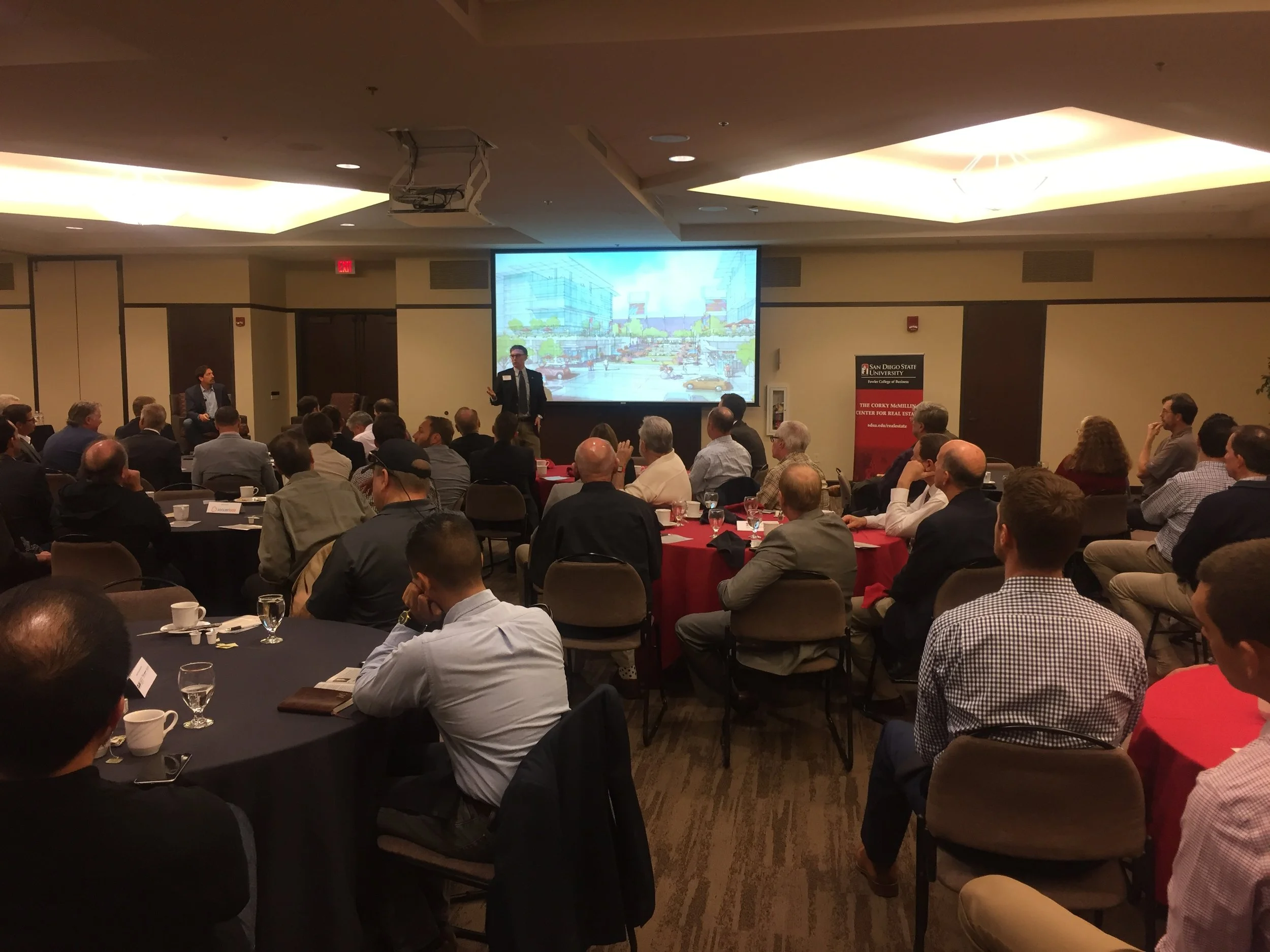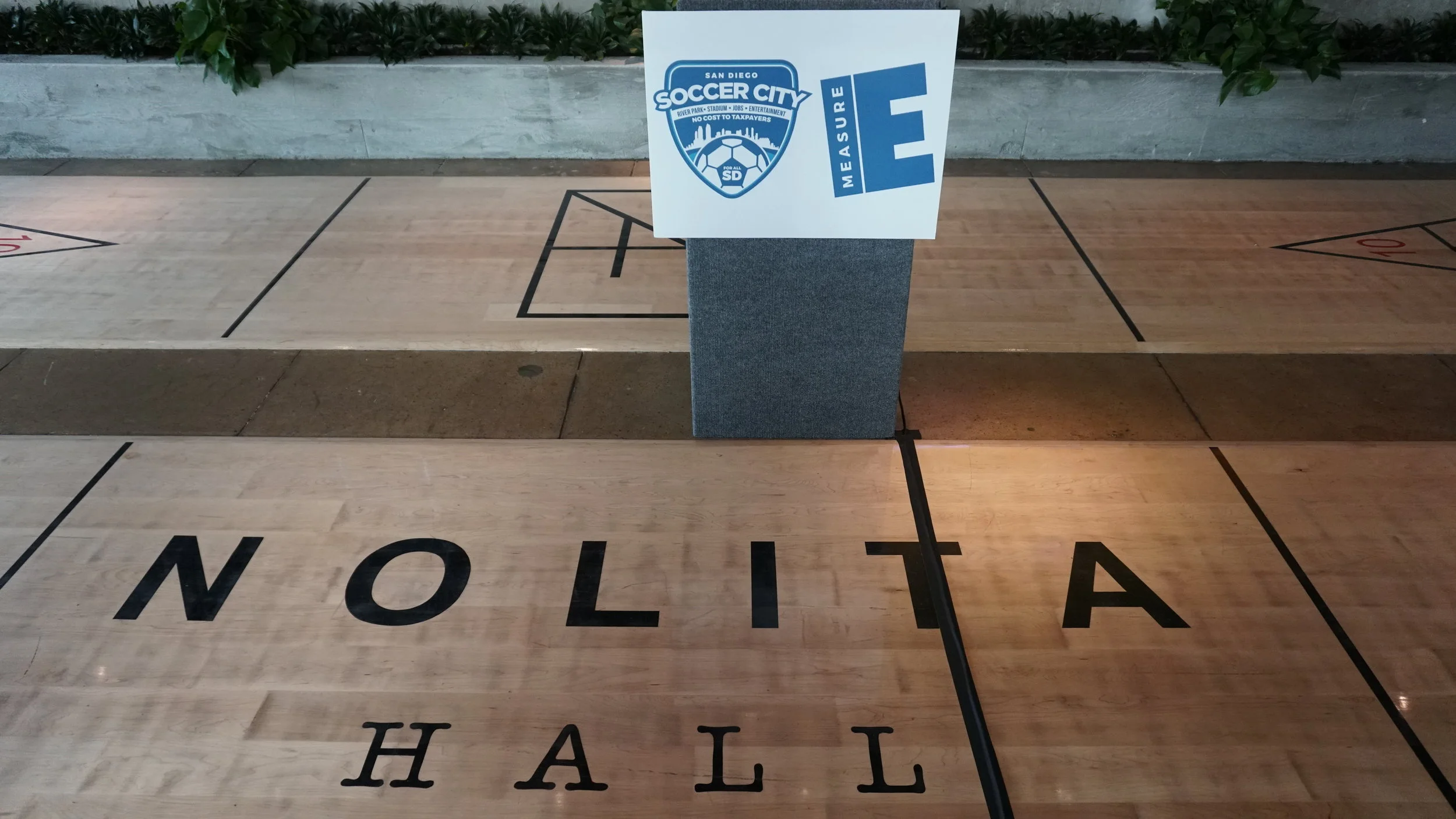SDSU's Vision for Mission Valley
On an overcast and cloudy Tuesday morning, the Corky McMillin Center for Real Estate's Parma Payne Goodall Alumni Center played host to a gathering of individuals keen to learn more about what the University's position is on the future of Mission Valley.
The breakfast was held conveniently just a day after the San Diego City Council voted unanimously to place the SDSU West ballot initiative on the upcoming general midterm election in November.
By now, many San Diegans are aware of the fact that there is a void to fill in the heart of Mission Valley in the wake of the Chargers' departure for Los Angeles. However, there are several thousand residents of America's Finest City who are either in the dark entirely when it comes to the options available this year, or are blind to the nuanced differences between the two plans each designed to fill the aforementioned breach left by the bolted Bolts.
This morning, attendees of the SDSU hosted breakfast were privy to an intimate presentation by JMI Realty CEO John Kratzer and SDSU Athletic Director JD Wicker. Over the course of an hour, the two walked the audience through the proposed layout of the expanded campus footprint.
This was no new thing. There have been presentations of this type going back years on years. The big difference about Tuesday's event is that for the first time, there is not only an actionable plan for the university's acquisition of the existing stadium site, but also a contrasting proposal that at a glance from a distance looks an awful lot like what the Friends of SDSU West have cooked up.
The Union Tribune carried a comprehensive summary of key similarities and differences of the overall plans:
- Stadium: The soccer-oriented facility, located at the northeast corner of the site and estimated at $100 million, would include room for 23,500 fans and could be expandable for Aztec football and other sports if the university becomes a partner. SoccerCity also is setting aside about 16 acres in case an NFL team signs a deal to return to San Diego in five years. The SDSU stadium, located at the northwest corner, would accommodate 35,000 fans and could be expanded by 20,000 seats to accommodate an NFL team.
- Housing: SoccerCity would include up to 4,800 homes, including some aimed at students and others set aside for low-cost affordable housing. SDSU would cap housing at 4,500 and include units set aside for students, faculty and staff with some left over for the general public and low-income renters. - Housing is one of San Diego's most urgent issues that needs to be addressed.
- Commercial space: SoccerCity proposes 2.4 million square feet of office space and 740,000 square feet of retail to carry out its plan to build a regionally-oriented sports and entertainment district. SDSU wants only 1.6 million square feet of office space that would be built for private use and ultimately converted to campus use. The 95,000 square feet of retail would serve residents and businesses onsite. SoccerCity has offered to sell 35 acres to SDSU for campus needs but the campus has declined because of the contemplated sales price.
- Hotels: Both plans include 400-450 hotel rooms with SDSU proposing to link its hotels to the university’s hospitality program.
- Parks: SoccerCity proposes 34 acres for the river park plus several soccer fields and an offsite soccer academy at the former Chargers headquarters on city-owned land in Murphy Canyon. SDSU proposes a 50-acre river park. Funding is somewhat in flux, since SoccerCity legally is required under its initiative to cover only $20 million of the park, although its backers have committed to the original $40 million figure had the project proceeded last year. SDSU has not outlined how its park would be financed. In both cases it’s likely developer impact fees and homeowner associations would cover all or part of the buildout and maintenance of the park. Other neighborhood parks and trails are envisioned in both plans.
- Land sale: SoccerCity proposes to buy slightly less than 80 acres of the property to avoid triggering a city charter requirement for voter approval of sales of 80 acres or more of city-owned property. The rest of the property would be leased for 99 years. SDSU proposes to buy 132 acres of the stadium site but not the river park, which would remain in city hands. Both sides anticipate paying the fair market value for the land as set by a city appraisal. SoccerCity would reserve the right to resell its land but SDSU plans to lease its land to developers. However the land is ultimately developed, users would pay their share of property, sales and hotel taxes.
- Stadium financing: The soccer stadium would be privately funded by SoccerCity investors, naming rights, concessions and user fees. SDSU would use state university bonds to build its stadium and pay off the bonds with stadium revenues. Both sides vow to finance the entire development without resorting to city general funds or new taxes. Only SoccerCity is clear about the actual funding mechanisms though.
- Parking: SoccerCity would build most of its 16,400 spaces in several parking garages, while SDSU would locate its 11,500 spaces largely out of sight and within the residential and commercial buildings. Both sides imagine many users, particularly stadium goers,would access the site via the existing trolley line and a future “Purple Line” on Interstate 805.
- Soil conditions: Unknown at this time is whether additional cleanup is needed at the site in case additional leaks are fund from the nearby Kinder-Morgan fuel tanks. The company previously cleaned up leaks and reached agreement with the city to address any future leaks that might be discovered.
"There's no reason our stadium can't have professional soccer," said Wicker after the event concluded. "There're USL teams (which could play at the Aztec Warrior Stadium), and I would imagine that if MLS wants to come to San Diego and there's a stadium that's available, MLS will figure out how they want to get there."
"I can't emphasize it enough: We need a partner in the stadium. its obvious that there's a strong soccer community here, there's a strong football community here and its a no brainer to bring the two together," concluded Wicker.
While it is certainly encouraging to take Wicker's words at face value, the reality is that as of today, there is no plan or process in place to afford for the expansion of Major League Soccer or the United Soccer League to plant a team in San Diego.
Additionally for many citizens, the lack of commitment to funding any open space parkland from the SDSU West initiative is a real concern. The way the SDSU West initiative is structured, the City of San Diego appears to be liable for financing the open space improvements.
There are still several months before the campaigning for "Yes" votes in November truly kicks into high gear, but anyone who is looking to make a decision is largely relying on trust when it comes to SDSU West, and facts when it comes to SoccerCity.






